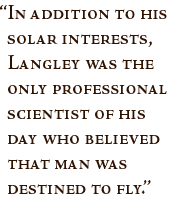

| In addition to his solar interests, Langley was the only professional
scientist of his day who believed that man was destined to fly. While
at the Allegheny Observatory, he made important experiments on the lift
and drag of an aircraft moving through the air at a measured speed.
Backed by these experiments, he was the first to offer a clear
explanation of the way birds soar and glide without appreciable wing
movement.
In 1886, he undertook a series of experiments on a rotating rig to measure the power needed to propel objects through the air. Encouraged by his findings, Langley set out to build a series of large working models of steam-powered flying machines he called "aerodromes," and, in 1896, became the first to build heavier-than-air machines capable of sustained (although uncontrolled) flight. Langley built two unmanned craft, each of which had two sets of 14-foot (4.3-meter) wings, weighed 26 pounds (11.8 kilograms), and were powered by steam engines.
Langley's first manned aircraft, powered by a five-cylinder air-cooled gasoline engine designed by Charles M. Manly did not fair as well as his unmanned craft. Piloted by Manly, the aircraft snagged upon launching from a catapult, and crashed into the Potomac River for the second and last time on Dec. 8, 1903, just nine days before the successful flights of the Wright brothers near Kitty Hawk, N.C. This aircraft had a wingspan of 48 feet (14.6 meters) and a total weight (with pilot) of 850 pounds (386 kilograms). Some authorities believe that if his catapult had not failed, Langley would have been the first to achieve sustained flight in a manned heavier-than-air machine. Langley's memory lives on in the names of the NASA Langley Research Center, the adjacent Air Force base, and several place names across the country. Our nation's first aircraft carrier, CV-1, built at the Norfolk Navy Yard in the early 1920's, was also named after Langley. next: Links and References
|
 On the Shoulders of Giants
Top: Langley's ill-fated "aerodrome" plunged into the Potomac River near Washington, DC on both of its launch attempts. (Photograph from the collection of the National Air and Space Museum) | ||